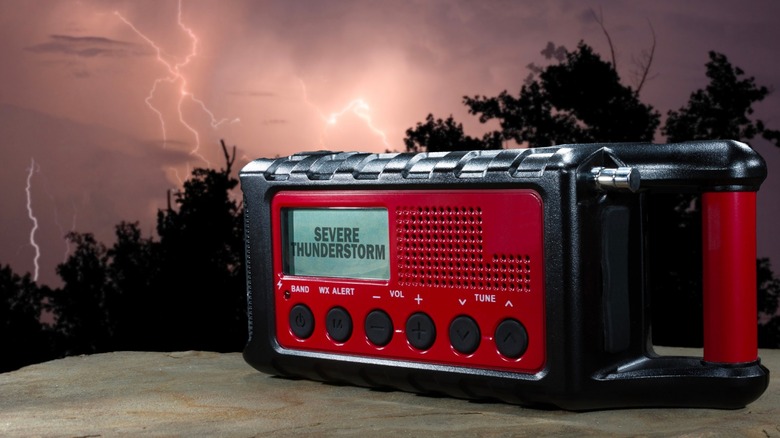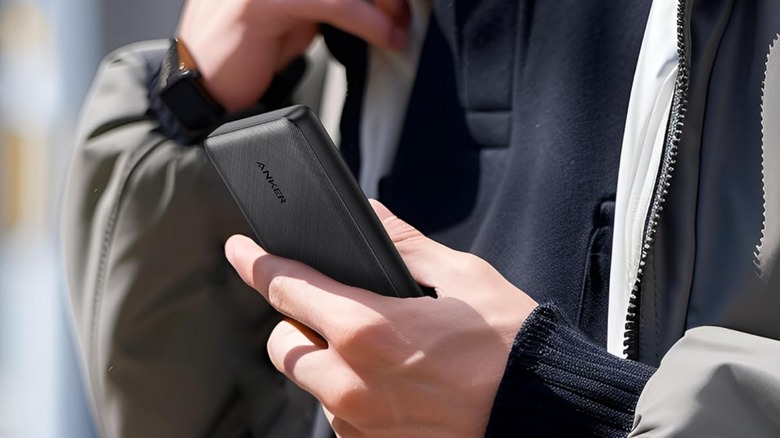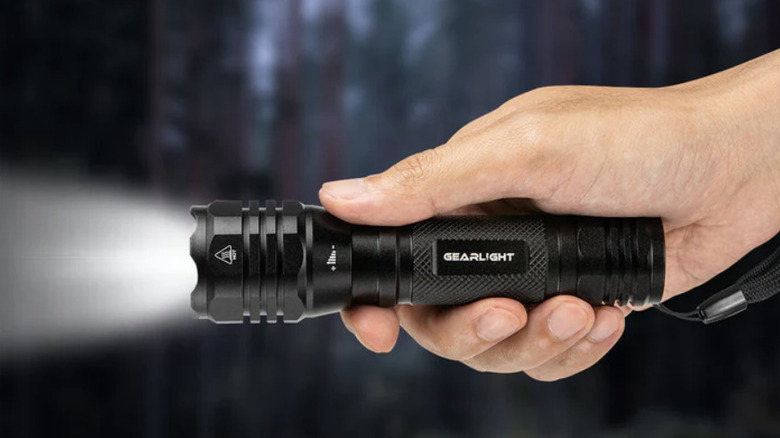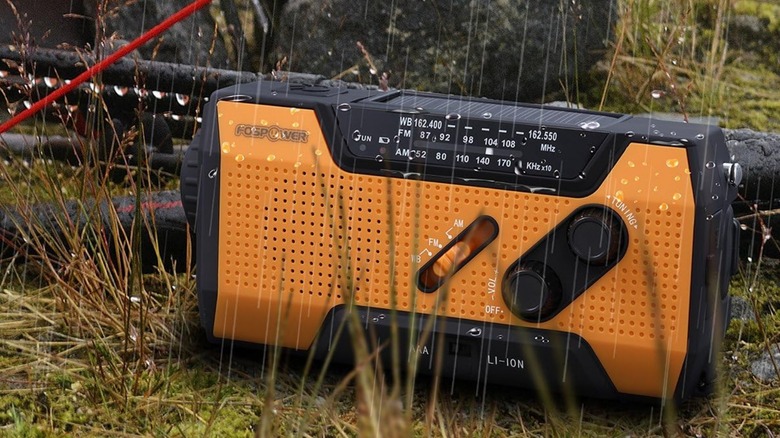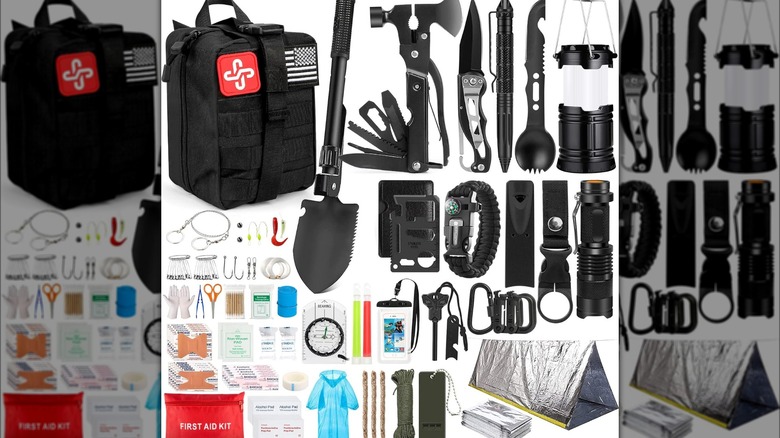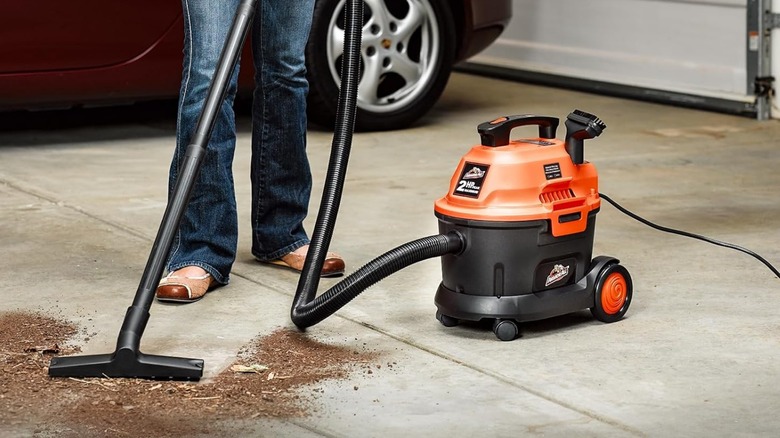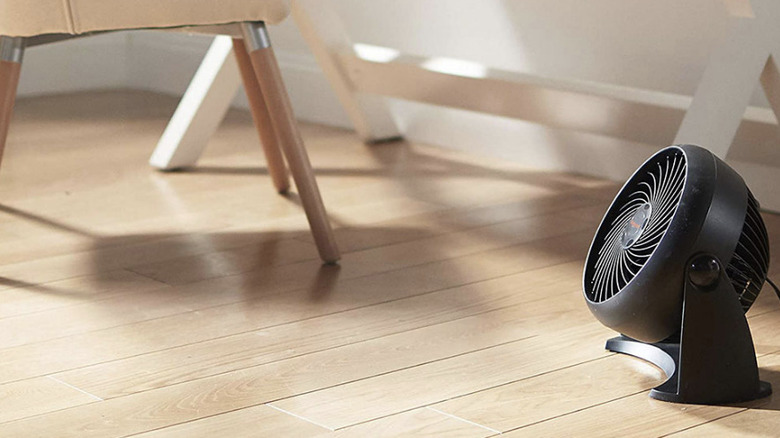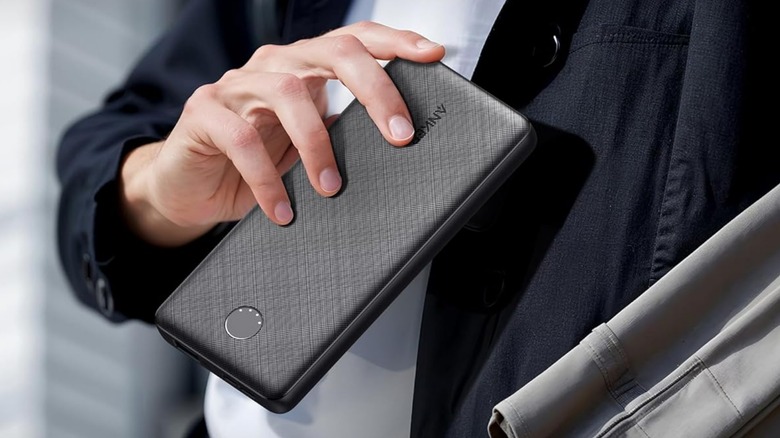6 Essential Gadgets You'll Want To Keep On Hand For Storm Season
We may receive a commission on purchases made from links.
Each year, millions are affected by seasonal storms. Things like hurricanes, tornadoes, snowstorms, and even regular old thunderstorms can cause immense amounts of damage and suffering. Extreme weather events are regularly to blame for serious flooding, sleet and hail, freezing temperatures, disastrous winds, and dangerous lightning strikes, and each of those issues can result in costly property damage, displacement, injury, or even death. Unfortunately and thanks to our changing climate, these storms are projected to become increasingly worse every year. That's a pretty depressing and scary fact, especially if you're one of the millions of people living in an area prone to severe storms.
As normal citizens, there isn't much we can do to change the weather. However, we can take steps to help prepare ourselves and our homes for extreme storms. Buying tools to prepare for a hurricane, identifying weak points in your home, stocking up on emergency supplies, and planning an escape route are all great ways to help keep yourself and your family safe during storm season. Some of those methods don't even require you to spend any money — you simply need to do some research and educate yourself about the best evacuation routes, storm patterns, and basic survival techniques.
That said, there are many different gadgets and devices that you can buy to help keep you safe and comfortable during severe weather. We scoured the net and selected six different types of products that you'll want to keep on hand for storm season. We chose these items based on things like features, price, and customer reviews, but we'll cover our methodology later. For now, check out these six essential gadgets that you'll want for storm season.
A solid power bank to charge your devices
Power banks have been around for a while now, and they've developed a reputation as popular and handy tools for on-the-go tech aficionados. Power banks come in different sizes and shapes, and many of them may have varying capabilities. However, the core function remains the same: to provide a compact and portable source of power for charging things like cell phones, laptops, and tablets on the go.
When it comes to purchasing a power bank, SlashGear covered the best brands from which you can choose. Most power banks will do similar things, but some have advanced features, like the inclusion of a flashlight, a wireless charging functionality, and built-in radios. You'll want to do a bit of research before settling on one specific product. Look into things like battery capacity, charge times, device compatibility, and extra features. If you're buying a power bank solely for emergency situations, extra features and TSA limits may not be important. However, if you're looking for a solid all-around power bank for traveling, daily use, and emergencies, you may want to look for something a bit more advanced.
As mentioned, many, many different power banks exist. If you're looking for a capable product to keep on hand for storm season, Amazon can be a great place to check. The Anker PowerCore 10K is a popular option with 4.5 out of five stars based on more than 100,000 user reviews. It works with iOS and Android devices, features USB-C connectivity, and can store enough juice to charge an iPhone 15 twice. Other solid choices include the Mregb Power Bank with built-in solar panel and flashlight and the INIU Portable Charger, which claims to be one of the slimmest on the market.
A powerful flashlight
Most people are familiar with flashlights and the way they work. They're basic but incredibly useful tools, and they're one of the most convenient devices you can have on hand during storm season. That said, there are a lot of different popular flashlight brands and styles out there. Similar to power banks, you can find flashlights that come with a wide range of features, from standard lighting devices to those capable of strobing and even charging your phone.
Just like when buying a power bank, you need to understand your own needs when shopping for a flashlight. One of the most important factors to consider when picking out a flashlight is brightness. In most cases, we measure a flashlight's brightness in lumens. Flashlights can range in brightness from less than 100 lumens to several thousand lumens. Generally speaking, most standard flashlights fall somewhere between 100 and 1,000 lumens, and most everything within that range will be adequate for helping you see during a power outage after a severe storm.
If you're looking for a solid flashlight to keep on hand for storm season, you've got a lot of options. Devices like the GearLight LED Flashlight Set come with excellent customer reviews and an affordable price tag. The kit includes two 1,040-lumen flashlights with multiple light modes and costs $19.99. Each light is drop and water-resistant, includes a carrying case, and takes one AAA battery. Other worthwhile options include Etekcity Lantern Kit and the Phixton Rechargeable 5,000-Lumen Flashlight.
An emergency radio
Severe storms can cause a lot of problems, including things like power outages, flooding, and property damage. However, one thing that many people living in urban or suburban areas may not consider is the risk of losing contact with friends and family during a serious and prolonged power outage. It's an issue that primarily affects those living in remote and rural areas, and while many may not consider it to be a huge deal, losing contact with the outside world can be extremely dangerous. If you live in a relatively remote region, an emergency radio could be a wise item to keep on hand, even if you don't live in an area prone to severe weather.
When shopping for an emergency radio, you'll want to look for a few features. It's important that you look for a radio that doesn't only receive FM signals — you'll need AM and VHF or very high frequency channels, like those used by NOAA, to hear important weather and news updates. Next, radios with multiple power sources — including battery, outlet, USB, etc. — can be significantly more useful if you don't have access to traditional power supplies. Finally, consider hunting for a radio with various features, like a built-in flashlight or external charging functionality.
Popular emergency radios can be found for under $50, like the RunningSnail Emergency Crank Weather Radio. It costs $36, features 4.6 out of five stars based on nearly 15,000 customer reviews, and comes with four distinct charging modes. Other popular models include the Raynic Emergency Radio, which features six charging options and a built-in phone charger, and the FosPower Emergency Weather Radio.
A disaster prep kit
Storm season poses a lot of risks. Many of us have grown accustomed to things like seasonal flooding, high winds, and broken tree limbs. However, considering the fact that these storms — and the destruction they bring — are projected to grow worse each year for the foreseeable future, it's a good idea to stay alert and ready for various types of catastrophes. Becoming complacent and forgetting to plan for increasingly dangerous storms can have disastrous consequences. That's why it's not only a good idea to keep several individual gadgets on hand — you should also invest in a well-stocked disaster preparedness kit to stay ready for whatever mother nature throws at you.
When it comes to disaster prep kits, you have a lot of options. You can curate and build your own using items you collect yourself, or you can choose to buy a pre-assembled kit. Regardless of whether you buy or build your disaster kit, there are a few things you should consider including. Items like collapsible shovels, compact emergency blankets, water purification tablets, first aid supplies, a compass, and some dehydrated food packs can be extremely useful to keep stored away for accidents and crises. You can expand on those items and include more devices. However, those are some of the most essential things you should include.
If you choose to buy a pre-built disaster kit, you may be surprised at the prices. They don't have to cost an arm and a leg, and it's not uncommon to find them for less than $50. Popular choices include the HIHEGD Survival Kit, which features 250 assorted emergency tools and devices, and the 238-piece Taimasi Emergency Survival Kit.
A wet/dry shop vacuum
One of the most debilitating effects of hurricanes and other extreme weather events is interior flooding. It's one thing for your driveway or yard to flood, but it's another beast entirely when that water creeps into your living space. It can cause massive amounts of damage to your home's structure and your furniture, and it can lead to other problems over time, like mold. The tricky thing about dealing with a flood is that it can be exceptionally challenging to remove the water.
In these situations, wet/dry shop vacuums can be lifesavers. These devices are similar to standard vacuums, but are capable of suctioning up liquids in addition to dust and other solids. They're common sights in garages and on jobsites, but they can also be excellent tools to keep on hand for storm season. Various brands build shop vacuums, and you have a lot of options when it comes to buying one. Some of the things you'll want to look for include a size appropriate for your needs, suction capabilities, filtration, power source, and any extra features.
As is the case with most of the items on this list, you don't have to break the bank when buying a shop vac. With 4.5 out of five stars based on nearly 30,000 customer reviews, the Armor All 2.5 Gallon Wet/Dry Shop Vacuum is one of the most popular shop vacs on Amazon and comes with a price tag of $69.99. The portable device comes with a 10-foot power cord and features a 2-horsepower motor for powerful suction. The Stanley 6 Gallon Wet/Dry Vacuum is another popular choice and comes with a 4-horsepower motor for $85.
A powerful fan
If your home floods after a severe storm, or you lose power for several days, you'll likely face a couple of distinct but related issues. We've already addressed one of those problems: the challenge you'll face trying to remove water from inside your home. The second issue that you may face is related to power outages — namely, you may be stuck without air conditioning for several days. Considering the fact that hurricanes and other severe storms tend to come during the summer, and that the areas most prone to this type of extreme weather also happen to be some of the hottest and muggiest parts of the country, that's a big deal.
Fortunately, there's a single device that you can buy to help combat both problems: a fan. Fans are supremely handy tools in general. They create airflow, allowing us to cool down our workspaces, clear out dust and fumes, and help us dry furniture or clothes. Those same benefits make fans great tools to keep on hand during storm season. You can use a fan to dry out carpets or cool yourself and your family while you wait for the A/C to come back.
Like the other gadgets covered here, fans don't have to be expensive. You can pick up a basic 11-inch fan, like the Honeywell TurboForce Fan, for under $20. The device is capable of 185 cubic feet of airflow per minute for maximum cooling and can blow air up to 27 feet. Other solid choices include the Hurricane Classic 20-inch Floor Box Fan and the efluky Rechargeable Desk Fan with LED Light.
Why did we choose these items?
To compile this list, we looked into the types of challenges posed by severe weather. We searched for gadgets that provide clear and obvious benefits to those living under the threat of seasonal storms, including things like providing power during a blackout and helping to recover after severe flooding or property damage.
Next, we chose to include examples of products for each category based on three primary criteria: price, features, and user reviews. First, we looked for products that won't break the bank. Dealing with severe weather is stressful enough, and we wanted to showcase products that provide affordable solutions to issues caused by extreme weather. As mentioned, we also considered product features, and we searched for items that offer real-world utility and benefits to those suffering after hurricanes and other types of seasonal storms. Finally, we considered user commentary, and we ultimately highlighted only products with more than four out of five stars based on thousands of customer reviews.
All of that said, remember to do your own research to understand your needs and the risks you face based on the area in which you live. Check weather reports, and learn about storm patterns in your region. Finally, don't forget to follow a few tips to keep your money safe when shopping on Amazon.
